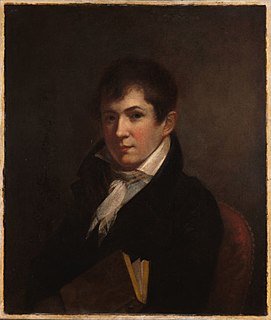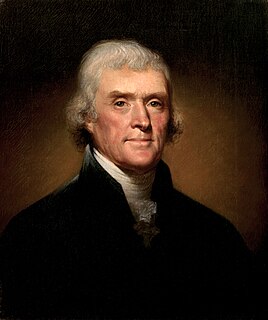Related Research Articles

Thomas Jefferson was an American statesman, diplomat, lawyer, architect, philosopher, and Founding Father who served as the third president of the United States from 1801 to 1809. He was previously the second vice president of the United States under John Adams and the first United States secretary of state under George Washington. The principal author of the Declaration of Independence, Jefferson was a proponent of democracy, republicanism, and individual rights, motivating American colonists to break from the Kingdom of Great Britain and form a new nation. He produced formative documents and decisions at state, national, and international levels.

The 1828 United States presidential election was the 11th quadrennial presidential election. It was held from Friday, October 31 to Tuesday, December 2, 1828. It featured a repetition of the 1824 election, as President John Quincy Adams of the National Republican Party faced Andrew Jackson of the Democratic Party. Both parties were new organizations, and this was the first presidential election their nominees contested.

Sarah "Sally" Hemings was an enslaved woman with one-quarter African ancestry owned by president of the United States Thomas Jefferson, one of many he inherited from his father-in-law, John Wayles.

Most United States presidents have kept pets while in office, or pets have been part of their families. Only James K. Polk, Andrew Johnson, and Donald Trump did not have any presidential pets while in office. However, Johnson did take care of some mice he found in his bedroom, feeding them, among other things.

Martha Skelton Jefferson was the wife of Thomas Jefferson. She served as First Lady of Virginia during Jefferson's term as governor from 1779 to 1781. She died in 1782, 19 years before he became president.

Martha "Patsy" Randolph was the eldest daughter of Thomas Jefferson, the third president of the United States, and his wife, Martha Wayles Skelton Jefferson. She was born at Monticello, near Charlottesville, Virginia.
Eston Hemings Jefferson was born into slavery at Monticello, the youngest son of Sally Hemings, a mixed-race enslaved woman. Most historians who have considered the question believe that his father was Thomas Jefferson, the third President of the United States. Evidence from a 1998 DNA test showed that a descendant of Eston matched the Jefferson male line, and historical evidence also supports the conclusion that Thomas Jefferson was probably Eston's father. Many historians believe that Jefferson and Sally Hemings had six children together, four of whom survived to adulthood.

Thomas Mann Randolph was an American planter, soldier, and politician from Virginia. He served as a member of both houses of the Virginia General Assembly, a representative in the United States Congress, and as the 21st governor of Virginia, from 1819 to 1822. He married Martha Jefferson, the oldest daughter of Thomas Jefferson, third President of the United States. They had eleven children who survived childhood. As an adult, Randolph developed alcoholism, and he and his wife separated for some time before his death.
John Hemmings was born into slavery at Thomas Jefferson's Monticello as a member of the large mixed-race Hemings family. He trained in the Monticello Joinery and became a highly skilled carpenter and woodworker, making furniture and crafting the fine woodwork of the interiors at Monticello and Poplar Forest.
The Jefferson–Hemings controversy was a historical debate over whether there was a sexual relationship between the widowed U.S. President Thomas Jefferson and his slave and sister-in-law, Sally Hemings, and whether he fathered some or all of her six recorded children. For more than 150 years, most historians denied rumors from Jefferson's presidency that he had a slave concubine. Based on his grandson's report, they said that one of his nephews had been the father of Hemings' children. Before changing his mind following the results of DNA analysis in 1998, Jefferson biographer Joseph J. Ellis had said, "The alleged liaison between Thomas Jefferson and Sally Hemings may be described as the longest-running miniseries in American history." In the 21st century, most historians agree that Jefferson is the father of one or more of Sally's children.

Madison Hemings was the son of the mixed-race enslaved woman Sally Hemings and her enslaver, President Thomas Jefferson. He was the third of her four children to survive to adulthood. Born into slavery, according to partus sequitur ventrem, Hemings grew up on Jefferson's Monticello plantation, where his mother was enslaved. After some light duties as a young boy, Hemings became a carpenter and fine woodwork apprentice at around age 14 and worked in the Joiner's Shop until he was about 21. He learned to play the violin and was able to earn money by growing cabbages. Jefferson died in 1826, after which Sally Hemings was "given her time" by Jefferson's surviving daughter Martha Jefferson Randolph.

The Monticello Association is a non-profit organization founded in 1913 to care for, preserve, and continue the use of the family graveyard at Monticello, the primary plantation of Thomas Jefferson, the third President of the United States. The organization's members are lineal descendants of Thomas Jefferson and his wife Martha Wayles Skelton Jefferson. The site is located just outside Charlottesville, Virginia. Thomas Jefferson was the designer, builder, owner, and, with his family, a first resident of Monticello.

Thomas Jefferson Randolph of Albemarle County was a Virginia planter, soldier and politician who served multiple terms in the Virginia House of Delegates, as rector of the University of Virginia, and as a colonel in the Confederate army during the American Civil War. The favorite grandson of President Thomas Jefferson, he helped manage Monticello near the end of his grandfather's life and was executor of his estate, and later also served in the Virginia Constitutional Convention of 1850 and at the Virginia Secession Convention of 1861.
Mary Jefferson Eppes, known as Polly in childhood and Maria as an adult, was the younger of Thomas Jefferson's two daughters with his wife who survived beyond the age of 3. She married a first cousin, John Wayles Eppes, and had three children with him. Only their son Francis W. Eppes survived childhood. Maria died months after childbirth.

Annette Gordon-Reed is an American historian and law professor. She is currently the Carl M. Loeb University Professor at Harvard University and a professor of history in the university's Faculty of Arts & Sciences. She is formerly the Charles Warren Professor of American Legal History at Harvard University and the Carol K. Pforzheimer Professor at the Radcliffe Institute for Advanced Study. Gordon-Reed is noted for changing scholarship on Thomas Jefferson regarding his relationship with Sally Hemings and her children.

Thomas Jefferson, the third president of the United States, owned more than 600 African Americans during his adult life. Jefferson freed two of his slaves while he lived; seven others were freed after his death. Jefferson consistently spoke out against the international slave trade and outlawed it while he was president. He privately advocated gradual emancipation and colonization of slaves already in the United States, rather than immediate manumission.
Harriet Hemings was born into slavery at Monticello, the home of Thomas Jefferson, third President of the United States, in the first year of his presidency. Most historians believe her father was Jefferson, who is now believed to have fathered, with his slave Sally Hemings, four children who survived to adulthood.

The Gardens of Monticello were gardens first designed by Thomas Jefferson for his plantation Monticello near Charlottesville, Virginia. Jefferson's detailed historical accounts of his 5,000 acres provide much information about the ever-changing contents of the gardens. The areas included a flower garden, a fruit orchard, and a vegetable garden. Jefferson, a connoisseur of trees, flowers, and gardening techniques, was highly interested in experimental planting and directed the design of the gardens, which contained many exotic seeds and plants from his travels abroad.

Thomas Jefferson, the third president of the United States, was involved in politics from his early adult years. This article covers his early life and career, through his writing the Declaration of Independence, participation in the American Revolutionary War, serving as governor of Virginia, and election and service as Vice-President to President John Adams.

In 1828, Andrew Jackson, who had lost the 1824 election in a runoff in the United States House of Representatives, despite winning both the popular vote and the Electoral vote by significant margins, ran for President of the United States. He had been nominated by the Tennessee state legislature in 1825, and did not face any opposition from Democratic candidates. Jackson launched his campaign on January 8, 1828, with a major speech on the 13th anniversary of the Battle of New Orleans from 1815, thus marking the birth of the modern Democratic Party. Jackson accepted John C. Calhoun, incumbent vice president under John Quincy Adams, as his running mate.
References
- ↑ Lopata, Peg. "A Real Political Animal." Faces: People, Places, and Cultures Sept. 2008: MasterFILE Premier. Web. 7 March 2010
- ↑ "Mockingbirds." Monticello.org. N.p., 29 August 8, 26, 2009. Web. 6 March 2010.
- 1 2 3 "Mockingbirds". Thomas Jefferson's Monticello. Thomas Jefferson Foundation Inc. Retrieved 16 November 2018.
- ↑ "For the Birds." Saturday Evening Post 279.3 (2007): 54–59. Academic Search Complete. EBSCO. Web. 3 March 2010.
- 1 2 Caulkins, Janet V. (1992). Pets of the presidents . Brookfield, Conn.: Millbrook Press. pp. 12, 14. ISBN 9781562940607.